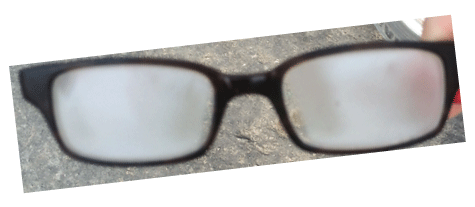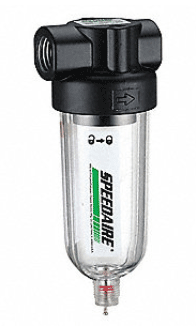Sometimes you may find water dripping from the exhaust of an air tool. If you are painting, you might get water spraying out of the paint gun. If your air line has a filter on it, water may be collecting in the air filter bowl. When you, as everyone does, right? – drain the air tank, water drips out. Why is there water in my compressed air?
If you have been fortunate enough to live in climates where the outside air approaches the freezing point, and doubly lucky to be having to wear glasses, you will have experienced the fogging up of the glasses when you have stepped into a warm house or office. Yup, the glasses immediately fog up! That this occurs is also why there is water in compressed air. Let me explain.

Air has moisture in it. The moist air inside the home or office (moister because lots of people are exhaling, moisture from hot water, showers, humidifiers etc.) will also condense on the glasses when that air encounters the cooler, or colder – depending on how cold it is outside, lens of the glasses. The colder outside, the colder the glasses, and the more condensation will occur until the glasses warm up to room temperature. Then no more condensate will occur.
Let’s think about what’s happening with an air compressor. What is essentially doing is “inhaling” huge amounts of air and forcing that air into a tank, thereby increasing the air pressure in the tank.
The compressor motor gets hot. The compressor pump gets hot. The process of driving air through a small orifice generates heat through friction. All of these ensure that the air entering the compressor tank if nice and hot… REALLY hot if the compressor has been running a long time.
Is it hot where the compressor is? That already hot air around the compressor is what the compressor is taking in. Then that hot air gets even hotter as it’s pumped into the compressor tank.
Remember how miserably hot it feels when the humidity outside is really high on a summer’s day? Well, the hot air that’s being dumped into the compressor tank is high in humidity too.
It’s high humidity and hot air going into the tank!
So we have hot air, full of water (which is what humidity is) being pushed into the relative coolness of the compressor tank.
Virtually instantly the water vapor in the new incoming air condenses out into liquid water and drips to the bottom of the compressor tank. And even though the tank temperature gets warmer, as it relates to the temperature of the air in the tank, the incoming air is always hotter. Condensation continues.
It then is only the amount of time the compressor runs, and the amount of humidity that is already in the incoming air (the relative humidity) while increasing the tank humidity level but reducing the amount of space that air can occupy (compressing the air) which forces even more water out of the air, and your compressor tank starts to fill with lots of water.
Big compressors can pump, literally, hundreds of gallons of water into the air tank or air lines in a single day. The little 1.5 HP, 3 gallon tank home compressor is simply a smaller version of the big, industrial compressors in terms of water generation.
Why is there water in my compressed air?
Simple.
The water is the tank is roiled up as the air exits the tank to the air lines when you are using compressed air, and that flowing of compressed air and water from the tank means that the air tool can become liberally dosed with water all the time you are using it.
What can you do about water in the compressed air?
There are not a lot of places where water in the air lines is welcome. In some cases it can be disastrous depending on what the compressed air is being used for.
First thing you can do to prevent water in the air lines is to drain the tank completely after every use. No point in starting a new project using compressed air and begin with the air from the tank bringing water left over from the last time you used the compressor.
Second thing you can do is install a compressed air filter or what’s sometimes known as a water trap, one like this:

Consider removing the coupler from the compressor, install a filter similar to the one shown, and then reinstall the coupler after the filter. This will trap water leaving the compressor air tank.
See the little lever sticking down below this Speedaire air filter? That’s a small drain valve, allowing the user to toggle it when there is air in the tank. The air in the tank will flow down and out the filter drain, taking all the water from the bowl with it.
Watch the water level in the bowl as you used compressed air, and drain the filter bowl as necessary.
That won’t get rid of all the water in the compressed air, but these two things are a good start.
Why won’t this get rid of all the water in the compressed air?
Depending on how big the air lines are, how long they are, how much air is being used, all mean that air in the lines will condense out water in the lines, since the water filter at the compressor typically only takes out liquid water, not water vapor.
As air flows down the air lines it cools, and water vapor still in the lines will continue to condense, turning into liquid water in the lines. That may be a big problem for you or not, again, depending.
The solution (pun intended) to that is to put another air filter in the air line just before the place where you are using the air. That will remove the free water in the air right there, and should mean that for most applications, the compressed air is water free.
Sure, there are some applications that require absolutely bone-dry air. While not common, they do exist, and folks lucky enough to require compressed air for those applications will have to add quite a bit more equipment at the air-use end to accomplish the air quality level they need. That expense, and it’s hefty, typically isn’t necessary for most folks.
Got a question about why there is water in my compressed air? Add it as a comment below and I expect you’ll get some help pretty promptly.


We have a Craftsman 60 gallon compressor (Model no. 919.165610; 240 V, 175 psi max pressure). We got very careless about draining the tank (actually went for a few years without doing so). We just drained the tank and got out a ton of water, along with some red mud (Maybe 5 gal of water? A lot.).
My question is, do we need to worry about safety considerations (tank exploding)? Should we have the tank pressure-tested (and if so, how do we find someone who can do this)?
The compressor is about 18 years old, works great, hold pressure well, and looks nice on the outside (it lives indoors, so the outside of the tank is still clean and shiny).
Thanks for any pointers!
First question about worry… sorry, I can only say maybe. What you might consider doing is with the compressor off and the tank empty, use a rubber mallet and starting at the top, tap all over the tank. Use the sound from the top of the tank as a guide to the bottom where all the water and yes, rust, was/is. Does the sound change a lot, as in going from a “ding” to a “thud”. Very subjective I know, but if the tank wall is weakening it won’t sound the same, and, you may even cave in a very weak spot a little, which would be sure indication that you need a new tank.
Pressure testing? Sure, expensive, and all you can do to find a tester is Google “pressure test pressure vessels” and add your location to see if any are around you. Some folks say you can do so yourself with a hand pump and a full tank of water (not air) but how effective that is I don’t know.